ADVANCE COURSE
FOR FINANCIAL ADVISORY
IFMC in Delhi, Noida, Ghaziabad, Shamli, Haryana & Pune
Home » Stock Market Training Classes » Advance Course For Financial Advisory
Advance your Career by Learning Financial Advisory in Just Four Months

About “Advance course for financial advisors” a four-month programme specially designed for all students and professionals who wish to specialize in the stock market. This is one of the programmes for all those who wish to do specialization in stock market trading (Equity, Equity Derivative, Currency & Commodity Markets) Technical Analysis, Research Analysis & Mutual Fund. This course covers Options Basic Strategies and Advanced Greeks.
Even those students who have done MBA Finance, Marketing and even HR or any other field can do specialization in share market which is the most upcoming sector of the financial market. The module is based on Theory as well as practical. The course includes Capital, Derivatives, Options, Commodity, and Currency Market Operations, in broking industry, Technical Analysis, Research analysis, Mutual Fund and, Option strategy in financial institutions and banks.
This is a four-month job oriented course in financial market a part of BFSI segment. This course is divided into three modules including preparation and certification of NSE and SEBI certificates + theoretical and practical on live software’s used in stock market trading.
Unique Feature of Advance Course For Financial Advisors
- A complete and comprehensive programme for all those who wish to specialize in stock market.
- A great add-on course along with Graduation, MBA.
- Industry recognized programme.
- Based on theory as well as practical for complete knowledge.
- You enter the industry completely trained and fit.
- Faculty with years of experience in Teaching and trading.
- Practice on Live Markets.
- The course will make you eligible for trading in Equity or Share Market, Futures & Options, Commodity and currency Market, Technical Analysis, Fundamental Analysis, Options Basic Strategies etc.
- 5-tier exposure Faculty, Practical Faculty, Older investor and Trader, Research Team, group discussion.
- Practical Classes daily with peer learning group under the mentorship of senior traders.
- Access to IFMC WATSAPP group
- Access to IFMC learning software’s for trading (UDTS-IS) and fundamental software (UDTS-VSM)
What You Will Get?
Get Complete Knowledge of all four markets Equity, Future & Options, Commodity and Currency.
- Get Complete practical training on Software used for online trading (ODIN Diet).
- Get Complete knowledge of Technical Analysis.
- Get Complete knowledge of Research Analysis.
- Get Complete knowledge of Mutual Fund.
- Get Complete knowledge of Option Strategy Certification.
Job Opportunities
A financial analyst works in the following areas: corporate finance, stock broking houses, investment management, and financial services including financial modeling.
Fees & Duration
- Registration Fees – Rs 1700/-
- Program Fee – Rs 55,000/-
- Program Duration 4 month
- Plus GST
Pay Full or Partial Course Fees
Detailed Curriculum
Module 1: Capital Market & It’s Operation
- Basic knowledge of capital market (Primary Market & secondary Market)
- Major Market Participants
- Major exchanges and indices
- Legal Framework and regulations
- Trading and Trading Membership
- Clearing and Settlement Process
- Fundamental Valuation concepts Glimpse of various trading software (ODIN, NEAT, NOW) Practical training of market operations
- Practical Classes daily from 10.00 am – 03.30 pm (live trading and methodology)
- Online Mock test (500 Question & answer test series) of NCFM Capital market module
Module 2: Derivatives Market & its Operations
- Introduction to Derivatives, Type of derivative contracts
- Understanding of future, forward, option and SWAP
- Future contracts, Mechanism & pricing of Forwarding contracts
- Understanding of Options and it’s (call & put)
- Trading, Clearing, and Settlement, Risk Management in Derivatives
- Regulatory Frame Work
- Accounting of Derivatives
- Practical Classes of 10 hours live trading and methodology (Futures & Options)
- Online Mock test (1000 Question & answer test series) of NISM Derivative market module
Module 3: Commodity Market
- Understanding Commodity Market
- Live Trading in Commodities – MCX and NCDEX
- International commodity Vs Domestic Commodity
Module 4: Currency Market
- Currency Derivative and its History
- Forward, Future and Options of currency derivative
- Trading, clearing, settlement & Risk Management of currency futures
- Different Strategy Use for Currency Derivative Trading
- Live Trading practices (2 Hours) in currency derivative segment
- Online Mock test (800 Question & answer test series) of NISM series1
Module 5: Technical Analysis
Introduction to Technical Analysis
What is technical analysis?
The basis of technical analysis
Difference between technical vs fundamental analysis
Type of Charts
Introduction to chart
The various types of price charts
- Line chart
- Bar chart
- Candlestick chart
- Kagi chart
- Point & Figure chart
- Renko chart
- Three Line Break chart
Trend lines
- What is the purpose of drawing trend lines?
- How to plot trend lines
Candlestick study
One candlestick pattern
- Doji
- Hammer/Hanging Man
- Inverted Hammer/Shooting Star
- Spinning Top
- Marubozu
Double candlestick pattern
- Bullish/Bearish Engulf
- Bullish/Bearish Harami
- Piercing pattern/Dark cloud cover
- Tweezer Top & Bottom
Triple candlestick pattern
- Morning star/Evening star
- Three white shoulders/Three black crows
- Abandoned body (Bullish & Bearish)
- Tasuki Gap (Bullish & Bearish)
Five candlestick pattern
- Rising three methods & falling three methods
Support & Resistance
- What is Support?
- What is Resistance?
- Change of support to resistance and vice versa
Charts patterns and their study
Four stages:
- Accumulation
- Markup
- Distribution
- Panic liquidation
Chart patterns:
- Head & Shoulder
- Inverted Head & Shoulder
- Double top/bottom
- Flag & Pennant
- Symmetrical, Ascending, Descending Triangles
- Wedge Patterns
- Rounding top/bottom
- Cup & Handle
- Rectangles Bullish/Bearish
- Triple top/bottom
Gaps & Gaps Analysis
Types of Gaps:
- Common gap
- Breakaway gap
- Runaway gap
- Exhaustion gap
- Island cluster
Oscillators & indicators
What does a technical indicator offer?
Why use indicators?
Types of indicators:
- Leading indicator
- Lagging indicator
Moving Averages
- Simple moving average
- Exponential moving average
- How to trade on moving averages
MACD
- what is the MACD and how is it calculated?
- How to trade on MACD
RSI
- What is momentum?
- Calculation of the RSI
- Divergence
- How to trade on RSI
On Balance Volume
- Overview
- Calculation of On Balance Volume
- How to trade on OBV
Stochastic
- Overview
- Construction
How to trade on stochastic
William %R
- Overview
- Signals
- How to trade on William %R
Bollinger bands
- Few rules for beginners
- How to trade on Bollinger bands
- How to use multiple indicators
Money Flow Index
- Overview
- How to trade on Money Flow Index
Trading strategy
The Dow Theory
- Background
- The principal rule of the Dow Theory
Elliot Waves theory
- Elliot wave basics
- How to trade on Elliot waves
Fibonacci sequence
- How to trade on the Fibonacci retracement
- How to trade on the Fibonacci extension
Trading psychology and how to manage the risk
Module 6: Option Strategy
Introduction To Options
- Option Terminology
- Options Payoffs
- Payoff Profile of Buyer of Asset: Long Asset
- Payoff Profile for Seller of Asset: Short Asset
- Payoff Profile for Buyer of Call Options: Long Call
- Payoff Profile for Writer (Seller) of Call Options: Short Call
- Payoff Profile for Buyer of Put Options: Long Put
- Payoff Profile for Writer (Seller) of Put Options: Short Put
Strategies
- Long Call
- Short Call
- Synthetic Long Call
- Long Put
- Short Put
- Covered Call
- Long Combo
- Protective Call
- Covered Put
- Long Straddle
- Short Straddle
- Long Strangle
- Short Strangle
- Collar
- Bull Call Spread Strategy
- Bull Put Spread Strategy
- Bear Call Spread Strategy
- Bear Put Spread Strategy
- Long Call Butterfly
- Short Call Butterfly
- Long Call Condor
- Short Call Condor
Module 7: Research Analyst
- Overview of NSE BSE MCX etc.
- Understanding Income Statements
- Balance sheet Analysis
- Cashflow Analysis
- Brief on Various Software
- How do Capital Markets Work Worldwide
- Fundamental vs Technical Analysis
- Top-Down and Bottom-up Approach
- Macro & Micro Aspects in relation to stock markets
- Markets affect by IIP, Inflation, PMI, Monetary Policy etc.
- Regression Analysis & Anova distribution
- Correlation & Covariance Analysis
- Financial terminology such as Buyback, Bonus, Corporate Actions etc.
- Quarterly Results Analysis
- Annual Reports Analysis
- Management Discussion
- Directors Reports
- How to read Company Annual Report & DRHP
- NPV & IRR Rules
- HPR & HPY
- Statistical Concepts & Market Returns
- Demand Supply & Elasticity Concepts
- Comparative Analysis.
- IPO Analysis
- Stock Portfolio Model.
- Descriptive Statistics Models.
- Understanding Standard Deviation & Variance.
- Understanding CAL, SML & CML equations.
- Markowitz Modern Portfolio Model.
- Skewness, Kurtosis & Range.
- Net Asset Value Analysis.
- Canslim Model by William J. ONeil
- Relative & Comps Techniques.
- Dividend Discount Model.
- Ratio Analysis e.g. ICR, Debt Equity, Pat margin, Debtors Equity etc.
- Step Wise Dupoint Analysis
- Sharpe & Treynor Ratio, Alpha & Beta Analysis
- PE, EPS, ROI, ROA Analysis
- Capital Budgeting & Cost of Capital
- Capital Asset Pricing Model
- Weak form, Semi-strong form, and Strong form Market Efficiency
- Company Analysis – Qualitative Dimensions
- Company Analysis – Quantitative Dimensions
- Banking Sector Terminology
- Mutual Fund Analysis.
- Basic Use of Excel & Techniques.
- Qualities of a good Research Report
- Time value of Money
- Forecasting Techniques.
- Revenue Builders.
- Building the asset and depreciation schedule.
- Building P&L & Balance sheet.
- Building Assumptions & Debt Schedule.
- Understanding FCFF, FCFI.
- Building Capex Schedule.
- Decoding Ke, Kd & Kp with WACC.
- CAPM and its understanding.
- EV/EBIDTA & SOTP Understanding Concepts
- Understanding Calculators
- Basics of Derivatives
- Forwards & Futures
- Put-Call Parity
- Basic Hedging Strategies for Analysts
- Live & Desk Cases on companies
- Knowledge sessions on undervalued & overvalued stocks
- Understanding Analyst Presentations
- Review of current Macro & Microtrends.
- Review on Global trends like Eurozone crisis, Oil crisis, and IT visa issues etc.
- Sessions will be including a mid-term and an end term examination.
Module 8: Mutual fund
- Concept of a mutual fund
- Functions of a mutual fund
- Advantages and limitations of a mutual fund
- Investment objectives
- Marking to market
- Unit capital
- Assets under management
- Fund running expenses
- Net asset value (NAV)
- Brief history of mutual funds in India
- Closed-end funds and open-ended funds
- Categorization of funds by investment objective
- Categorization of funds by investing horizon
- Categorization of funds by asset class
- International funds
- Fund of Funds
I. Fund Structure and Constituents
- Structure of mutual funds in India and related regulations
- Role of the sponsor, trustee and Asset Management Company (AMC) and related regulations
- Role of other fund constituents and related regulations
II. Legal and Regulatory Environment
- Role of regulators in India
- Role and functions of SEBI in regulating mutual funds
- Self regulatory organizations
- Role and functions of AMFI
- AMFI Code of Ethics
- Investment restrictions and related regulations
- Investor rights and obligations
III. Offer Document
- Regulations with respect to drafting and filing of an Offer Document for NFO
- Process of NFO and steps involved in marketing an NFO
- Objectives of information disclosure in an offer document
- Objectives and contents of the Statement of Additional Information (SAI) and related regulations
- Objectives and contents of the Scheme Information Document (SID) and related regulations
- Key Information Memorandum (KIM) and related regulations
IV. Offer Document
- Regulations with respect to drafting and filing of an Offer Document for NFO
- Process of NFO and steps involved in marketing an NFO
- Objectives of information disclosure in an offer document
- Objectives and contents of the Statement of Additional Information and related regulations
- Objectives and contents of the Scheme Information Document and related regulations
- Key Information Memorandum and related regulations
- Fund Distribution and Sales Practices
- Types of investors and eligibility
- Distribution channels for mutual funds
- Pre-requisites to become a mutual fund distributor
- Key elements of agreement between distributor and a mutual fund
- Sales practices and commission structure
- Types of commissions and transaction charges
- AMFI Code of Conduct
- Process for KYD
V. Accounting, Valuation and Taxation
- Computation of net assets and NAV
- Announcement of NAV
- Factors affecting the NAV
- Pricing of transactions in a mutual fund
- Time-stamping of transactions
- Charging of expenses
- Key accounting and reporting requirements
- Valuation process carried out by mutual funds
- Applicability of taxes
- Dividend Distribution Tax
- Taxability of dividends and capital gains in the hands of a mutual fund investor
- Applicability of Securities Transactions Tax based on type of transaction and scheme
- Setting off gains and losses under Income Tax Act
VI. Investor Services
- KYC requirements & Demat Account concept
- Process for fresh and additional purchase in a mutual fund
- Additional documentation requirements for institutional investors
- Acceptable payment instruments
- Processes related to redemptions by investors
- Contents and periodicity of Statement of account
- Process for Nomination and Pledge
- Types of Investment options – dividend, growth and dividend re-investment
- Processes related to of systematic investment plans
- Processes related to systematic withdrawals and transfers
- Processes related to other investor services and facilities
VII. Risk, Return and Performance of Funds
- Return on investment
- Calculation of simple, annualized and compounded returns
- Applicability of returns for different types of funds
- SEBI norms for return representation of mutual funds in India
- Factors that may affect mutual fund performance
- Risks in different type of mutual funds
- Classification of mutual funds based on risk
- Process for Benchmarking of performance
VIII. Scheme Selection
- Steps in selecting equity funds
- Steps in selecting debt funds
- Steps in evaluating a money market fund and identifying factors impacting their performance
- Steps in evaluating balanced mutual funds and evaluation of factors impacting their performance
- Sources of data to track mutual fund performance
IX. Selecting the Right Investment products for Investors
- Classification of assets into physical and financial assets
- Features of physical assets such as gold and real estate
- Features of financial assets
X. Helping Investors with Financial Planning
- Basics of financial planning
- Financial goals
- Investment horizon
- Objective of financial planning
- Benefits and need for financial planning to the investor
- Life cycle and wealth cycle in financial planning
- Tools to categorize investors’ needs
XI. Recommending Model Portfolios and Financial Plans
- Risk profiling
- Asset allocation and types
- Importance and steps for developing a model portfolio
Who Should Do This Course?
- MBA & BBA/CA/CS/CPT Students
- Anyone who wants experts in the financial market
- 10+2, BA. B.com. B.Sc. Pursuing Students
- Those who want to pursue the career in financial service
Career Opportunity
You can become an EQUITY ANALYST, RESEARCH ANALYST, STOCK ANALYST, you become fit for various other posts in various other verticals depending on your overall Qualifications.
Admission Criteria and Eligibility:
- The candidate should be Minimum 12th (Senior Secondary) pass from any recognized Board/institutions. We always recommend the candidate should pass at least bachelor degree so that it will be a bit easier to provide placements. Graduate students get job placement on the direct payroll in big companies, and 12th students will get placement in small companies or in sub-brokers office.
- *placement guarantee refers to (After getting NCFM and NISM Certification of all 10 modules covered in adv. diploma course)
- All original documents-10th,12thgraduation, other professional degree certification and mark sheets must be submitted in as a self-attested copy/copies at the branch at the time of admission and originals must be shown to the center In Charge, failing which admission may be cancelled
- 95%attendence is must during the programme in each module opted by the student.
- Remarks /Recommendation of faculty and center Head will be taken in the record after each class
- Your certification depends on your Attendance, class assessment, projects, internal exams, NSE exams, Practical classes, Projects and Viva
- The decision of Center in Charge and center Head will be final.
Query Us















